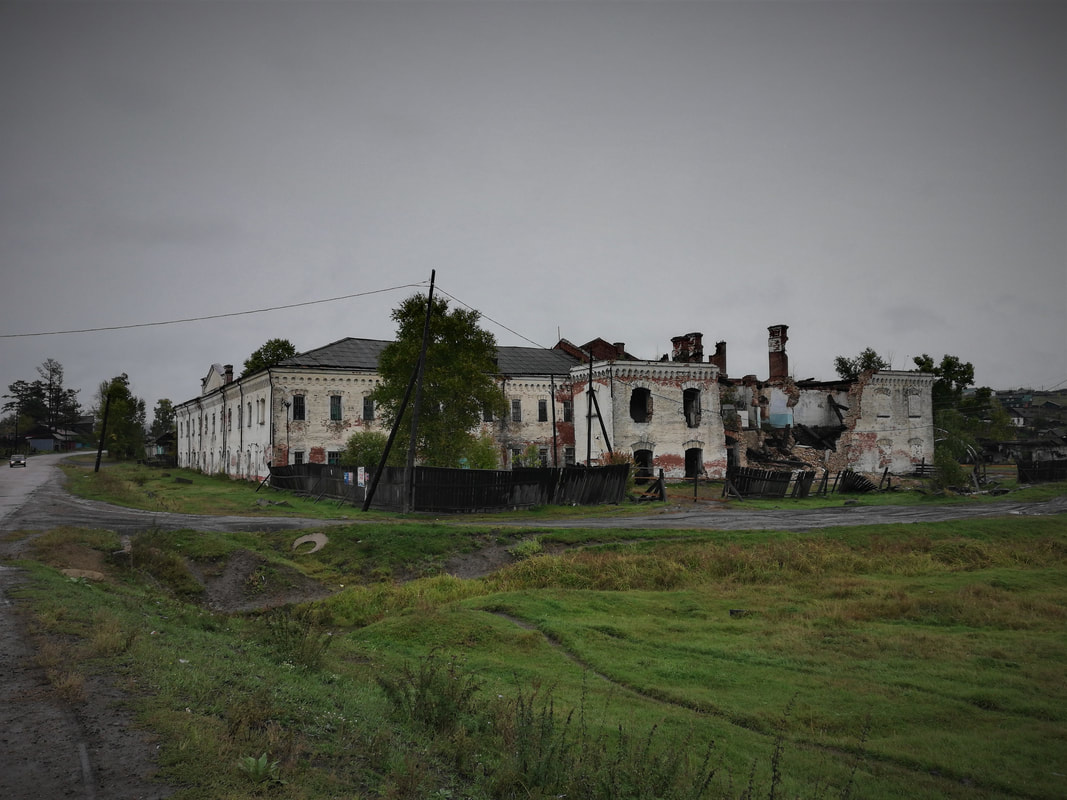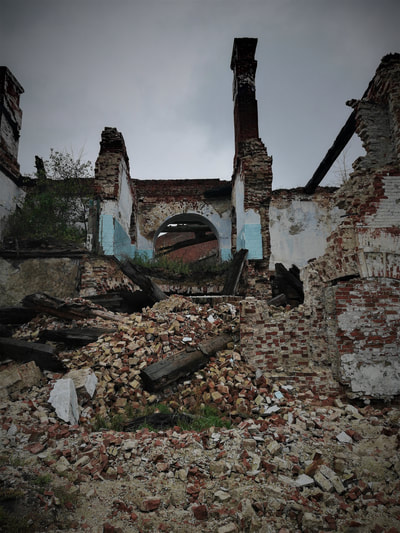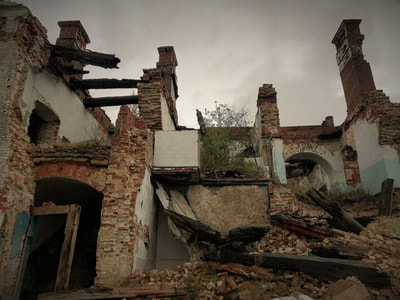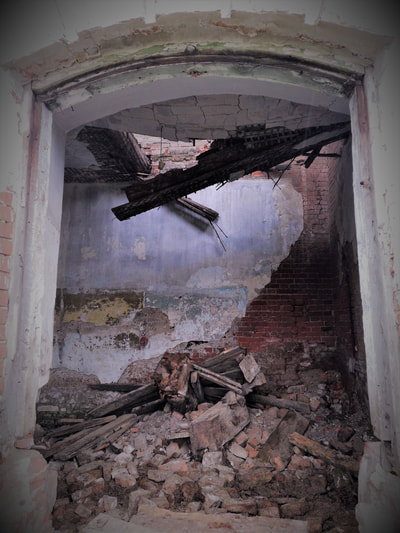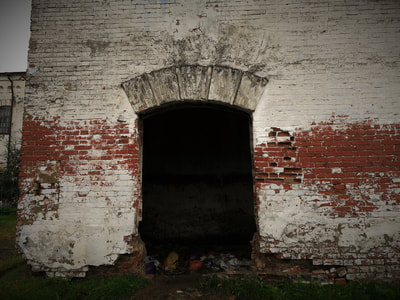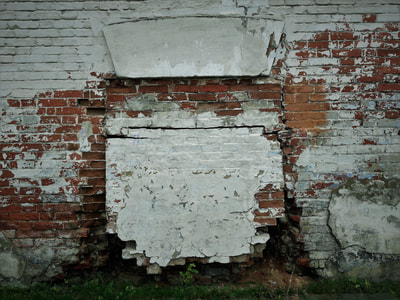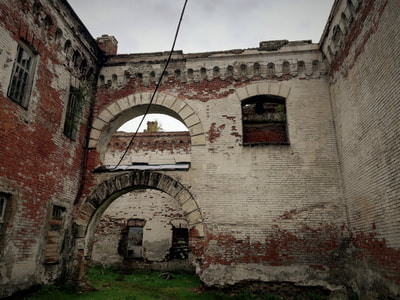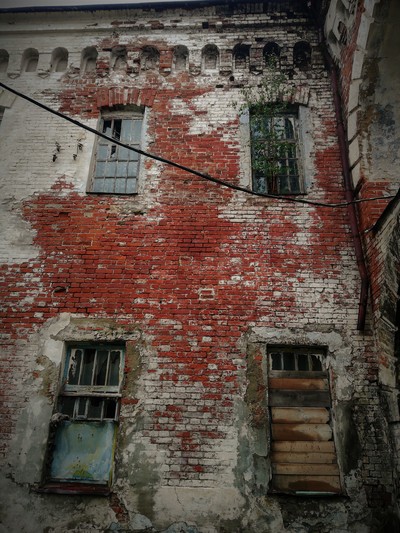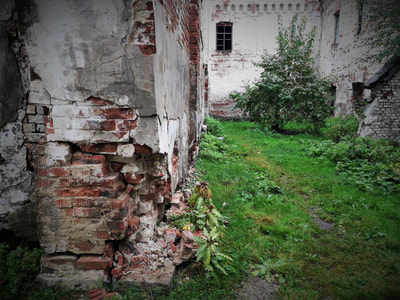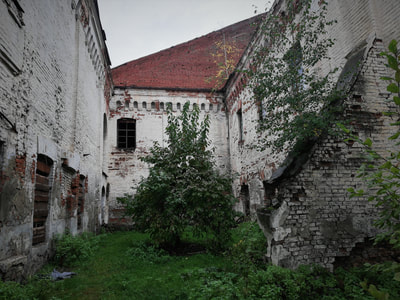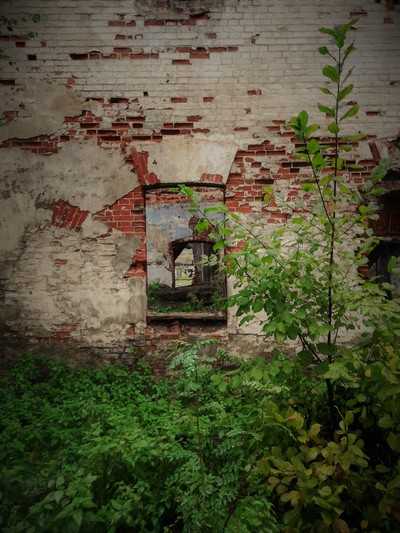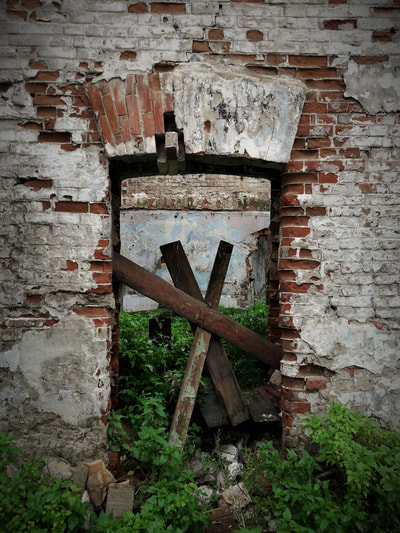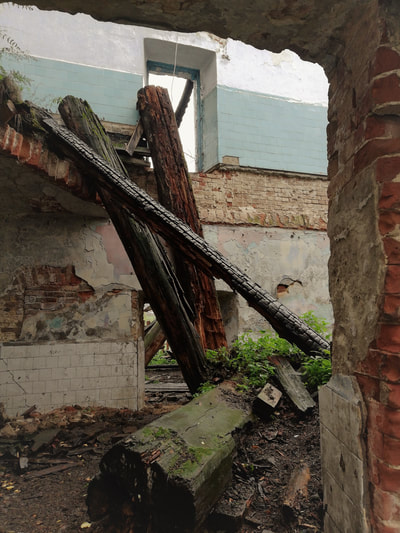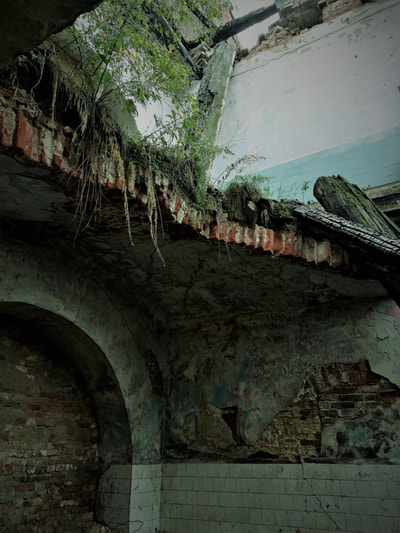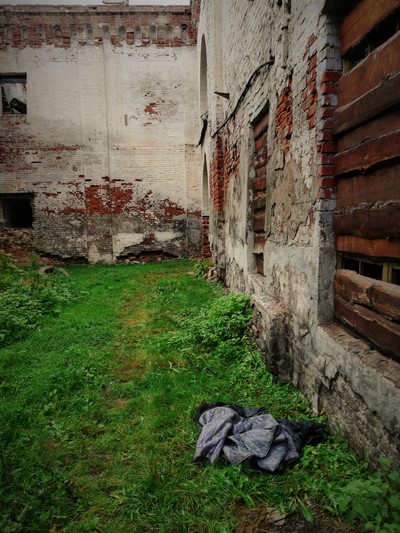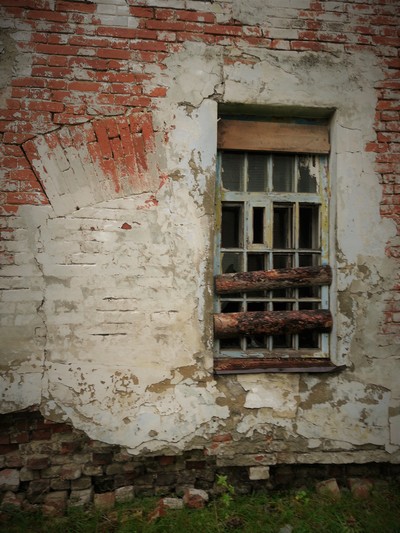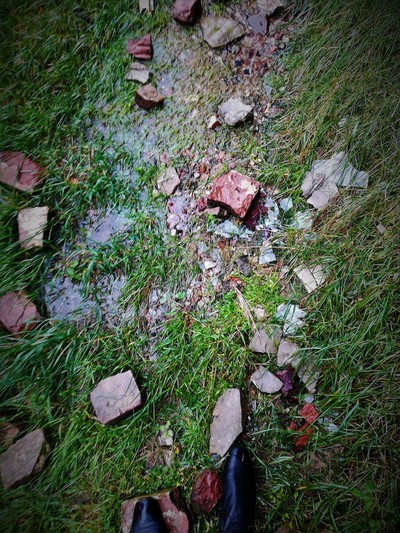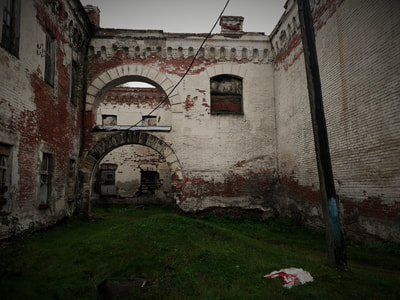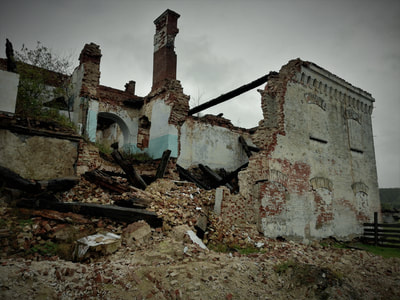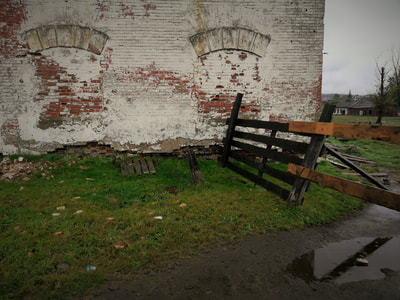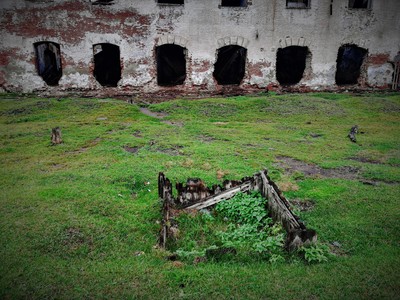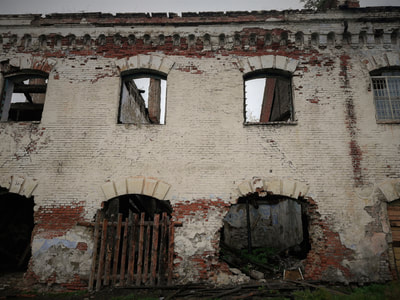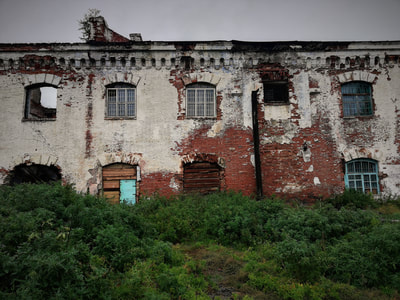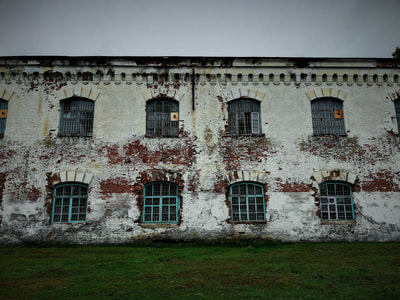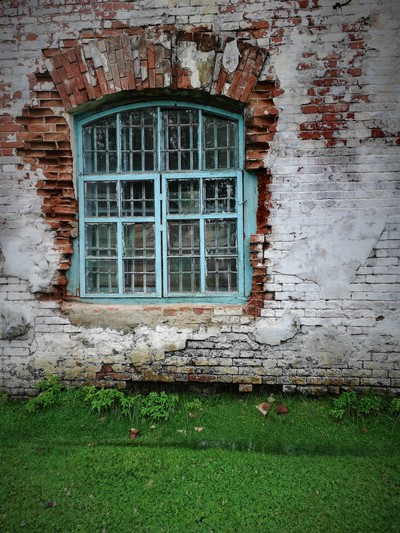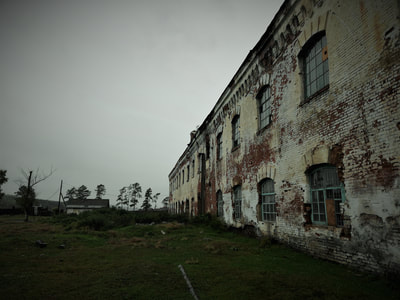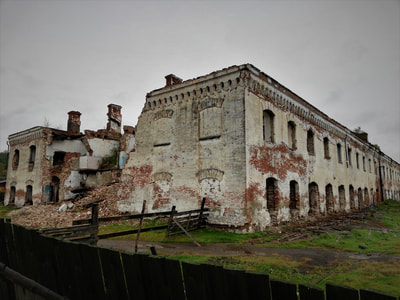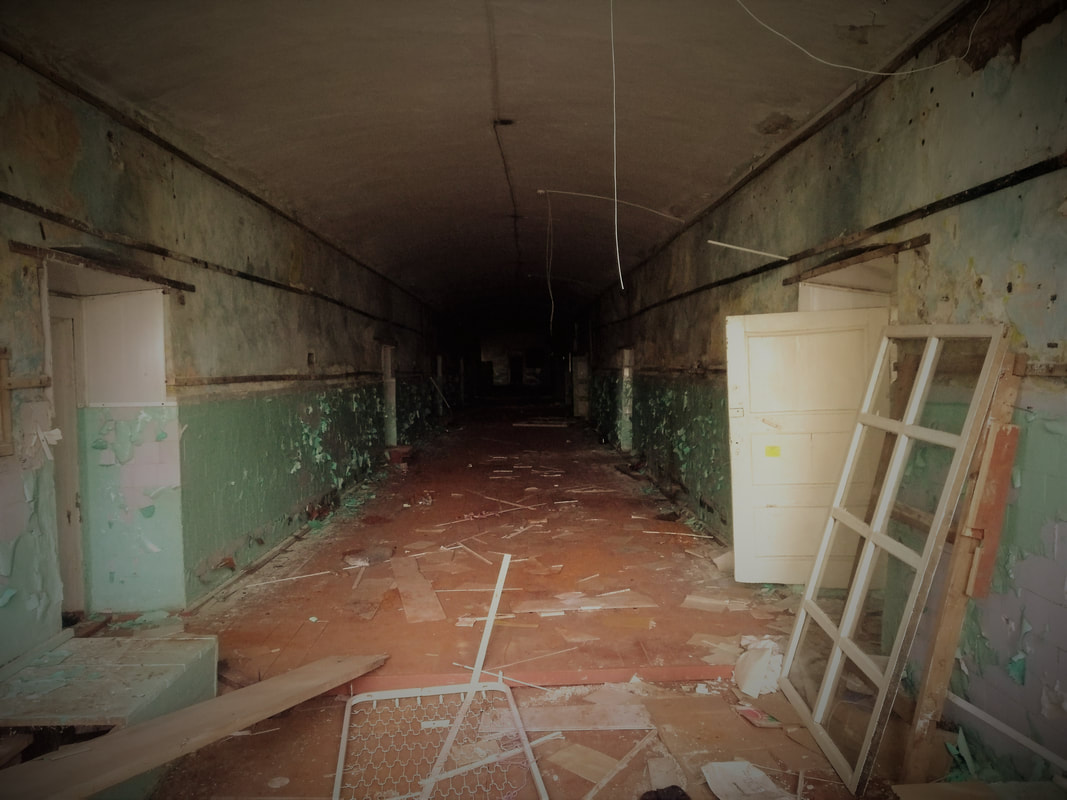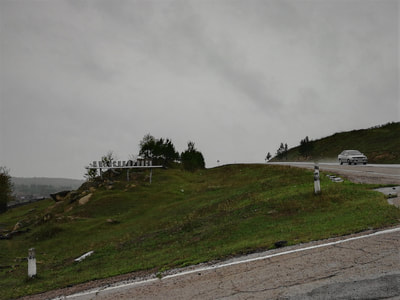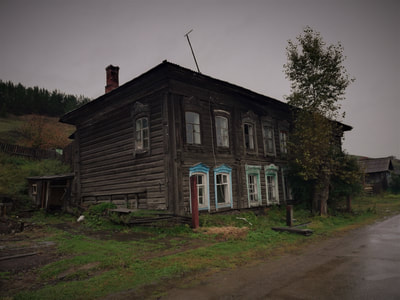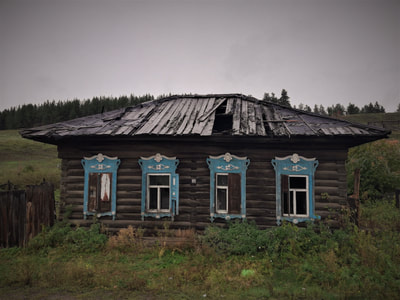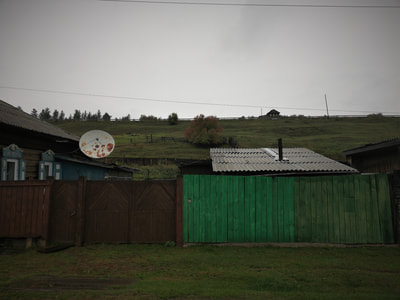Alexandrovsky tsentral (central prison) is a legendary place in Siberia. Alexandrovsky tsentral resurfaces in local conversations. People refer to it as an enchanted place, haunted and enigmatic. Alexandrovsky tsentral was established in 1873 on the territory of the distillery that was also a kind of a camp. The distillery emerged at unknown time; biologist and ethnographer Johann Gottlieb Georgi mentions it in his work Bemerkungen einer Reise im Russischen Reich im Jahre 1772 published in Saint Petersburg in 1775. Tsentrals, central prisons, in the tsarist Russia, were subsidized by the central authority, whereas the usual prisons were funded by the local council (zemstvo).
After Alexandrovsky tsentral had been a prison, it became a psychiatric institution in 1956 - a Psychiatric Irkutsk Hospital number 2. The psychiatric institution was denied its license in 2012, but was closed only in 2016 through the efforts of civil rights defenders. The civil rights defenders worked hard to make the authorities admit that the conditions do not correspond to any standards of humane treatment. The mental health hospital was overcrowded to the point when sometimes only two square meters were allocated to one person (Vertinskaya, 2014). The hygienic conditions were far from tolerable too. Human rights commissioner Valery Lukin photographed the horrifying broken-tile-clad bathrooms in 2014.
Unfortunately, after the hospital was evicted, there was no institution to take on the building, a historic memorial, upon its care to preserve it as least in the conditions that it was.
After Alexandrovsky tsentral had been a prison, it became a psychiatric institution in 1956 - a Psychiatric Irkutsk Hospital number 2. The psychiatric institution was denied its license in 2012, but was closed only in 2016 through the efforts of civil rights defenders. The civil rights defenders worked hard to make the authorities admit that the conditions do not correspond to any standards of humane treatment. The mental health hospital was overcrowded to the point when sometimes only two square meters were allocated to one person (Vertinskaya, 2014). The hygienic conditions were far from tolerable too. Human rights commissioner Valery Lukin photographed the horrifying broken-tile-clad bathrooms in 2014.
Unfortunately, after the hospital was evicted, there was no institution to take on the building, a historic memorial, upon its care to preserve it as least in the conditions that it was.
The place layered as manufacture, prison, and psychiatric hospital simultaneously as if encompasses three of the institutions that Foucault describes as a pivotal means for the disciplining of the body and making it obedient to the state, its laws, the societal rules and demands. The prison and the psychiatric institutions are the utopias of control and order. Both are established with a view of the elimination of evils and improvement of the societal fabric by detaining the elements of society that went astray, personified in inmates and patients. The history of Alexandrovsky tsentral demonstrates that obedience was not in a habit of many of its inhabitants. Over the years, the events of the Russian and Siberian histories, intertwined but not identical streams of stories, ideas, and imaginaries, are inscribed in the thick walls of the tsentral.
The informational sheet of Narodnaya volya (Listok Narodnoi Voli; People's Will was a political organization active in 1879-1887 promoting a radical change employing terror in order to force the government conduct political reforms). In 1882, the sheet described describing the road from Tomsk to Irkutsk as follows: "When everything is ready [the preparations for the road are done], instead of the customary in such matters: "Lord, bless us!", a command resounds: "Load the rifles, keep them ready! If anyone thinks to run--fire!" And the procession embarks wiggling on the dirty road. The wet snow falls, liquid dirt splashed from under the horses' hooves and pours upon the travelers in such abundance that soon they transmute into some fantastical creatures. Those sitting on the edges risk to fall every minute, which is exactly what unseldom happens. The road is the murderous to the degree that horses go out of their force, barely move their legs, and stop. This way the whole day and a greater part of the night is spent."* (Narodnaya volya, 1882, quoted by Ivanov, 2014; translation is mine).
This road description is striking because just now, to photograph Alexandrovsky tsentral, I had to stop en route Ust Uda-Irkutsk, during which the waves of red liquid clay poured upon the windshield in abundance, and the road that I travel to the primal place of my fieldwork, Mooia-Anosovo, is going to fit the above description even today, with the only difference that, even though horses are no longer in use as the main means of transportation, jeeps and landrovers, all kinds of off-road vehicles, multi-tone trucks, swamp buggies and what not barely move and get stuck in the clay like flies in glue.
The transitional prison for those sent into the camps of the Eastern Siberia from the European part of Russia also functioned in Alexandrovsk. From here, ssylnokatorzhnie (exiled to the camps) were forwarded further East and North--to the Lena River gold mines, to the Usolie, Ust-Kut (Kationov, 2009), and other towns' manufactures--to Yakutsk district and beyond Baikal (Ivanov, 2014).
Since the 1890s, exiled to the camps worked at the construction of Trans-Siberian Mainline. As late as 1904-07, despite that the labor of the exiled and sentenced to camps began to be substituted for the hired labor, the inmates and dwellers of Alexandrovsky tsentral worked on the construction of the second railway of the Trans-Siberian Mainline, and some, on the inner prison works (Kationov, 2009). Through the transitional prison, (peresylnaya turma), known politicians and officials of the future Bolshevik state went: Felix Dzerzhinsky in 1902, Mikhail Frunze in 1914, Sergo Ordzhonikidze in 1915-16 (mzk1, 2017).
The land is still haunted with the images of the Soviet revolutionists. At the stairs of Ust Uda hotel Chance, I encountered a man in a light red jacket with the inscription Columbia who, describing to me his impressions from visiting Alexandrovsky tsantral, in a voice trembling of admiration said that Dzerzhinsky raised the strike on the second day he was enclosed in the prison, after which he had to be put in an isolation ward. In fact, Dzerzinsky, who at the time was 25, with the health undermined by two years of imprisonment, was the chairman of the committee of the declared on the territory of the tsentral independent republic that rejected the rule of the Russian empire. After the prison guards were evicted from the tsentral and the red flag with the inscription "Freedom" was raised above it, Dzerzhinsky preceded over the committee in the negotiation with the vice governor urgently summoned by the officials to resolve the conflict. The sent to the exile to camps demanded the return of the freedoms they enjoyed previously, when their position was markedly different from that of the sentenced to the tsentral, and their cells were open and they could walk "the comparatively big yard" (as described by Dzerzhinsky in the letter to his sister), had a library and could read books, could go, with the armed escort to the settlement store, and so on. They also demanded to know where they will be sent further, as this information was kept secret. The negotiations went well, the vice governor was compliant, and agreed to return the previous privileges without any repercussions towards the rebels. Dzerzhinsky was soon sent to the town of Verkholensk. (Ratkovsky, undated).
This road description is striking because just now, to photograph Alexandrovsky tsentral, I had to stop en route Ust Uda-Irkutsk, during which the waves of red liquid clay poured upon the windshield in abundance, and the road that I travel to the primal place of my fieldwork, Mooia-Anosovo, is going to fit the above description even today, with the only difference that, even though horses are no longer in use as the main means of transportation, jeeps and landrovers, all kinds of off-road vehicles, multi-tone trucks, swamp buggies and what not barely move and get stuck in the clay like flies in glue.
The transitional prison for those sent into the camps of the Eastern Siberia from the European part of Russia also functioned in Alexandrovsk. From here, ssylnokatorzhnie (exiled to the camps) were forwarded further East and North--to the Lena River gold mines, to the Usolie, Ust-Kut (Kationov, 2009), and other towns' manufactures--to Yakutsk district and beyond Baikal (Ivanov, 2014).
Since the 1890s, exiled to the camps worked at the construction of Trans-Siberian Mainline. As late as 1904-07, despite that the labor of the exiled and sentenced to camps began to be substituted for the hired labor, the inmates and dwellers of Alexandrovsky tsentral worked on the construction of the second railway of the Trans-Siberian Mainline, and some, on the inner prison works (Kationov, 2009). Through the transitional prison, (peresylnaya turma), known politicians and officials of the future Bolshevik state went: Felix Dzerzhinsky in 1902, Mikhail Frunze in 1914, Sergo Ordzhonikidze in 1915-16 (mzk1, 2017).
The land is still haunted with the images of the Soviet revolutionists. At the stairs of Ust Uda hotel Chance, I encountered a man in a light red jacket with the inscription Columbia who, describing to me his impressions from visiting Alexandrovsky tsantral, in a voice trembling of admiration said that Dzerzhinsky raised the strike on the second day he was enclosed in the prison, after which he had to be put in an isolation ward. In fact, Dzerzinsky, who at the time was 25, with the health undermined by two years of imprisonment, was the chairman of the committee of the declared on the territory of the tsentral independent republic that rejected the rule of the Russian empire. After the prison guards were evicted from the tsentral and the red flag with the inscription "Freedom" was raised above it, Dzerzhinsky preceded over the committee in the negotiation with the vice governor urgently summoned by the officials to resolve the conflict. The sent to the exile to camps demanded the return of the freedoms they enjoyed previously, when their position was markedly different from that of the sentenced to the tsentral, and their cells were open and they could walk "the comparatively big yard" (as described by Dzerzhinsky in the letter to his sister), had a library and could read books, could go, with the armed escort to the settlement store, and so on. They also demanded to know where they will be sent further, as this information was kept secret. The negotiations went well, the vice governor was compliant, and agreed to return the previous privileges without any repercussions towards the rebels. Dzerzhinsky was soon sent to the town of Verkholensk. (Ratkovsky, undated).
Alexandrovsky tsentral has a remarkable place in the folk songs. The song "Far-away in the Irkutsk land" has two versions within each of which variability flourishes. One of the versions portrays a scene of a young barin (nobleman) demanding a yardman told him the name of the owner of such a glorious mansion, a gilded two-headed eagle glistens on the facade:
"Ты скажи-ка, подметала,
Что за дом такой стоит?
Кто хозяин тому дому?
Как фамилия гласит?"
"Tell me, yardman,
What is this house?
Who is its owner?
What is his last name?"
Podmetala (yardman, sweeper), in the early version of the song, responds:
"Это, парень, дом казенный,
Александровский централ.
А хозяин сему дому
Сам Романов Николай".
"This is, young man, a public house,
Alexandrovsky tsentral.
And the owner of this house
Is Nicolas Romanov himself."
Sweeper concluded that in this house, people were tormented, tortured, and locked in the dungeon. The song had transformed many times answering to the shifting political realities of the day. The first version was put together no later than 1880 when the first hear of it was recorded (Eliasov, 1957). In the later versions, sweeper directed at the young nobleman the pain people experienced in the walls of the prison and told him in the Russian idiomatic expression: "The tears will out-pour to the wolf," which means, those in charge will sooner or later be brought to answer for all the injustices that they inflict on others. Upon hearing this threat, the nobleman hit his horses and disappeared.
Around 1918-1919, when the prison vacated after the February Revolution (1917), the walls again were filled with suffering bodies and moans of pain they emitted under torture during the rule of the imperial-Russia admiral Alexander Kolchak, the "supreme leader" of Russia in 1918-1920, until the day of his execution. The second rendition of the song spawned at this period of the Alexandrovsky tsentral's history. It has a different story, even though in the video that I found it starts with the same line. In most versions of the song on the same motif, the first couplet is absent (a-pesni, undated). In the version that I found, the song shares the first couplet with the earlier version, albeit significantly changed. The couplet retains the main function: it provides the expository settings:
Far-away in the Irkutsk land
Between two huge cliffs,
Surrounded by the high wall,
Alexandrovsky tsentral [stands].
Далеко в стране Иркутской
Между двух огромных скал,
Обнесен стеной высокой,
Александровский централ.
The song tells a story: an old woman, a mother, came to the gate of the prison on Sunday. Some versions of the song mention the distance she had to cross to arrive by the gate: forty versts (26.5 miles). She brought her son a care package. She implores the guard to pass it on to her son:
"Pass on the care package,
Because people say
That the convicts in prisons
Are subjected to hunger too much."
"Передайте передачу,
А то люди говорят,
Что по тюрьмам заключенных
Сильно голодом морят".
But the guard replies with an ambiguous sentence that he clarifies only in the next utterance. He says: there is no son of yours. Your son was convicted yesterday and sent to another world. The mother replies:
"Передайте передачу
На помин его души.
Я купила передачу
На последние гроши".
"Pass on the package
For people to commemorate him.
I bought this package
With my last money."
With this, the mother turns away from the prison gate and goes on her way, and "no one knows what she's carrying in her heart."
No one knows what is going on in heart and soul of the mother whose son is imprisoned and killed, and no one knows every tragic story among many that transpired in these walls.
"Ты скажи-ка, подметала,
Что за дом такой стоит?
Кто хозяин тому дому?
Как фамилия гласит?"
"Tell me, yardman,
What is this house?
Who is its owner?
What is his last name?"
Podmetala (yardman, sweeper), in the early version of the song, responds:
"Это, парень, дом казенный,
Александровский централ.
А хозяин сему дому
Сам Романов Николай".
"This is, young man, a public house,
Alexandrovsky tsentral.
And the owner of this house
Is Nicolas Romanov himself."
Sweeper concluded that in this house, people were tormented, tortured, and locked in the dungeon. The song had transformed many times answering to the shifting political realities of the day. The first version was put together no later than 1880 when the first hear of it was recorded (Eliasov, 1957). In the later versions, sweeper directed at the young nobleman the pain people experienced in the walls of the prison and told him in the Russian idiomatic expression: "The tears will out-pour to the wolf," which means, those in charge will sooner or later be brought to answer for all the injustices that they inflict on others. Upon hearing this threat, the nobleman hit his horses and disappeared.
Around 1918-1919, when the prison vacated after the February Revolution (1917), the walls again were filled with suffering bodies and moans of pain they emitted under torture during the rule of the imperial-Russia admiral Alexander Kolchak, the "supreme leader" of Russia in 1918-1920, until the day of his execution. The second rendition of the song spawned at this period of the Alexandrovsky tsentral's history. It has a different story, even though in the video that I found it starts with the same line. In most versions of the song on the same motif, the first couplet is absent (a-pesni, undated). In the version that I found, the song shares the first couplet with the earlier version, albeit significantly changed. The couplet retains the main function: it provides the expository settings:
Far-away in the Irkutsk land
Between two huge cliffs,
Surrounded by the high wall,
Alexandrovsky tsentral [stands].
Далеко в стране Иркутской
Между двух огромных скал,
Обнесен стеной высокой,
Александровский централ.
The song tells a story: an old woman, a mother, came to the gate of the prison on Sunday. Some versions of the song mention the distance she had to cross to arrive by the gate: forty versts (26.5 miles). She brought her son a care package. She implores the guard to pass it on to her son:
"Pass on the care package,
Because people say
That the convicts in prisons
Are subjected to hunger too much."
"Передайте передачу,
А то люди говорят,
Что по тюрьмам заключенных
Сильно голодом морят".
But the guard replies with an ambiguous sentence that he clarifies only in the next utterance. He says: there is no son of yours. Your son was convicted yesterday and sent to another world. The mother replies:
"Передайте передачу
На помин его души.
Я купила передачу
На последние гроши".
"Pass on the package
For people to commemorate him.
I bought this package
With my last money."
With this, the mother turns away from the prison gate and goes on her way, and "no one knows what she's carrying in her heart."
No one knows what is going on in heart and soul of the mother whose son is imprisoned and killed, and no one knows every tragic story among many that transpired in these walls.
The tsentral has numerous stories of revolts and escapes, most unsuccessful and ending with beatings, prolonged confinement, and execution. By December 2018, the citadel contained 1204 inmates. On the 8th of December, a group of inmates escaped. They were shot and some were killed, but eighty people still ran away in the morning, and in the evening, their number grew. The next day, the tsentral was surrounded by the joint forces of Alexandrovsky garrison, rangers, and members of the Czech Legion (mzk1, 2017). That's when the song about the mother belatedly visiting her imprisoned son was enriched with the development of the plot: he was condemned by the military men of the Czech Legion, and only stars know when they pronounced their sentence. Upon her returning to her home, she is embracing his children and wife:
- Вы, сиротки, вы сиротки,
Ты, несчастная жена.
Так за что же расстреляли
Чехи родного сынка?
- You, orphans, you orphans,
You, unlucky wife.
Why did the Czechs shot
[My] own son?
The legend still alive that the Czech Legion came into possession of a part of imaginary or real Kolchak's gold, the rest of which he reportedly drowned in Baikal; the Czech memoirs recollect the unlawfulness that the soldiers of the White Army conducted hiding behind the Czech armor, and the White Army's memoirs accuse the Czechs of the same (a-pesni, undated).
- Вы, сиротки, вы сиротки,
Ты, несчастная жена.
Так за что же расстреляли
Чехи родного сынка?
- You, orphans, you orphans,
You, unlucky wife.
Why did the Czechs shot
[My] own son?
The legend still alive that the Czech Legion came into possession of a part of imaginary or real Kolchak's gold, the rest of which he reportedly drowned in Baikal; the Czech memoirs recollect the unlawfulness that the soldiers of the White Army conducted hiding behind the Czech armor, and the White Army's memoirs accuse the Czechs of the same (a-pesni, undated).
The settlement of Alexandrovsk, still called differently on different maps (Alexandrovsk, which is what is written in concrete letters at the entrance, or Alexandrovskoye, as my phone's geolocation informed me and many articles refer to the place), for centuries had been built around and accounting for the functioning Alexandrovsky tsentral, in different capacities. Not unoften the inmates, having served their sentences or freed from the psychiatric ward, settled right there, around the walls of the familiar place. The tsentral was a gradoobrazuyushchee enterprise--town-building, town-forming enterprise where many of the dwellers of the settlement worked. As I lamented the progressing loss of the memorial of architecture which is Alexandrovsky tsentral, I cast a glimpse around and saw the settlement of Alexandrovsk as it is now; the vision was reminiscent of the ethnographic museums "under the open sky," like Taltsy and the Angarsk River Village (Angarskaya derevnya). The whole of rural Siberia appeared to my sight of an in-some-sense foreigner as the museum of byt (everydayness), only this museum was happening here and now, and for curators tirelessly shuffling and rearranging the objects of the everyday use (the objects that appear precious and indispensable to me in their very discardability), this "museum" had every single one of the contemporaries.
The barn in the settlement of Alexandrovsk was one mark of the past. The remnants of one wooden house still had a roof covered with dranka—rough wood boards that come after the tree trunk is splintered like wood chips. Dranka is usually produced without the use of machinery such as power-saw bench; the wedge is stuck in the truck and splits it along its length, the carpenter Alexander Pinigin told me. Nowadays easier-obtainable materials are used for covering the roof, and the pieces of tarpaper remained--the traces of the owners' attempt to preserve the house. Things slip into the abandonment regardless of our desire to keep them afloat. Alexandrovsky tsentral, as well as the settlement of Alexandrovsk, could use some force that does not promise to appear to preserve and transform the place. But the marks of some other, alternative utopia, are also visible, whether it is a satellite dish adorning an old house or the new bright-yellow truck parked on the lawn in front of a gate.
The barn in the settlement of Alexandrovsk was one mark of the past. The remnants of one wooden house still had a roof covered with dranka—rough wood boards that come after the tree trunk is splintered like wood chips. Dranka is usually produced without the use of machinery such as power-saw bench; the wedge is stuck in the truck and splits it along its length, the carpenter Alexander Pinigin told me. Nowadays easier-obtainable materials are used for covering the roof, and the pieces of tarpaper remained--the traces of the owners' attempt to preserve the house. Things slip into the abandonment regardless of our desire to keep them afloat. Alexandrovsky tsentral, as well as the settlement of Alexandrovsk, could use some force that does not promise to appear to preserve and transform the place. But the marks of some other, alternative utopia, are also visible, whether it is a satellite dish adorning an old house or the new bright-yellow truck parked on the lawn in front of a gate.
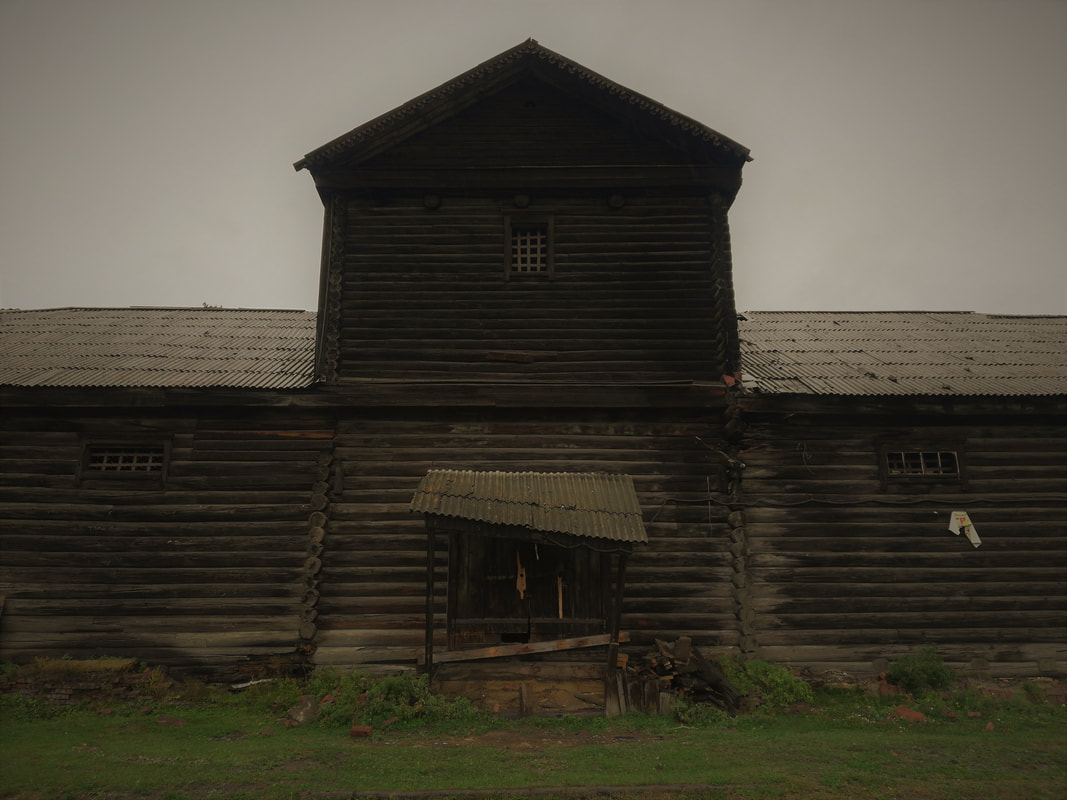
Today, Alexandrovsky tsentral is the celestial citadel containing specters. I documented, with my phone, the gaps that used to be walls and windows. The right wing of the building suffered in particular. From what was the roof, and now is the yawning void, the heavy wooden balks, black, wet, moss-covered, loomed above the ground threatening to fall. In other rooms, balks were already on the land. The cold rain dripped. Under one window, the nondrying wetness proliferated, cultivating, by the constant moisture over the summer, the emerald-green, almost-tropic-looking area of lush grass. Here and there the red bricks breaking through the layers of white paint hang loose about to fall out. In the photographs that I saw on the web, Alexandrovsky tsentral still had the roof and looked somewhat less resolutely abandoned. A birch tree grew in the second-story window, heart-shaped leaves trembling in the piercing wind. A lost coat lay prostrate in grass, like it was everything left after the unnamed son of the old woman.
_________
*«Когда все готово, вместо обычного в таких случаях: «Господи, благослови!», раздается команда: «Заряди ружья, держи их на взводе! Если кто вздумает бежать – стрелять!» И поезд двигается в путь, извиваясь по грязной дороге. Падает мокрый снег; жидкая грязь брызжет из-под копыт лошадей и в таком изобилии обдает путников, что они вскоре превращаются в какие-то фантастические существа. Сидящие по краям, ежеминутно рискуют упасть, что нередко и случается. Дорога до того убийственна, что лошади выбиваются из сил, едва передвигают ноги и останавливаются. Таким образом едут целый день и значительную часть ночи…». Народная воля, 1882.
*«Когда все готово, вместо обычного в таких случаях: «Господи, благослови!», раздается команда: «Заряди ружья, держи их на взводе! Если кто вздумает бежать – стрелять!» И поезд двигается в путь, извиваясь по грязной дороге. Падает мокрый снег; жидкая грязь брызжет из-под копыт лошадей и в таком изобилии обдает путников, что они вскоре превращаются в какие-то фантастические существа. Сидящие по краям, ежеминутно рискуют упасть, что нередко и случается. Дорога до того убийственна, что лошади выбиваются из сил, едва передвигают ноги и останавливаются. Таким образом едут целый день и значительную часть ночи…». Народная воля, 1882.
References
A-pesni, "V voskresenie mat'-starushka," folk song. A-pesni: песенник анархиста-подпольщика. Undated, http://a-pesni.org/grvojna/kr/vvoskrmat.php
Eliasov, L. Y. Народная революционная поэзия Восточной Сибири эпохи гражданской войны. Улан-Удэ, 1957. Quoted at A-pesni: песенник анархиста-подпольщика. Undated, http://a-pesni.org/popular20/dalekovstrane.php
Ivanov, Alexander. Путь сибирский дальний, 12-02-2014, http://penpolit.ru/papers/detail2.php?ELEMENT_ID=1188
Kationov, O.N. Александровский централ // «Историческая энциклопедия Сибири» (2009). http://irkipedia.ru/content/aleksandrovskiy_central_istoricheskaya_enciklopediya_sibiri_2009
mzk1.ru, Aleksandrovsky tsentral, 2017. http://www.mzk1.ru/2017/08/aleksandrovskij-central/
Narodnaya volya. 1882. № 8-9 // Литература социально-революционной партии «Народной воли». Типография партии социалистов-революционеров, 1905. С. 547-548. Quited by: Ivanov (see above).
Vertinskaya, Yekaterina. Psikhiatrichesky tsentral. Radio Svoboda. January, 27, 2014. https://www.svoboda.org/a/25243581.html
Ratkovsky, Ilya. Vtoraya ssylka F.E. Dzerzhinskogo: bunt v Aleksandrovskom tsentrale. Undated. https://cyberleninka.ru/article/n/vtoraya-ssylka-f-e-dzerzhinskogo-bunt-v-aleksandrovskom-tsentrale
